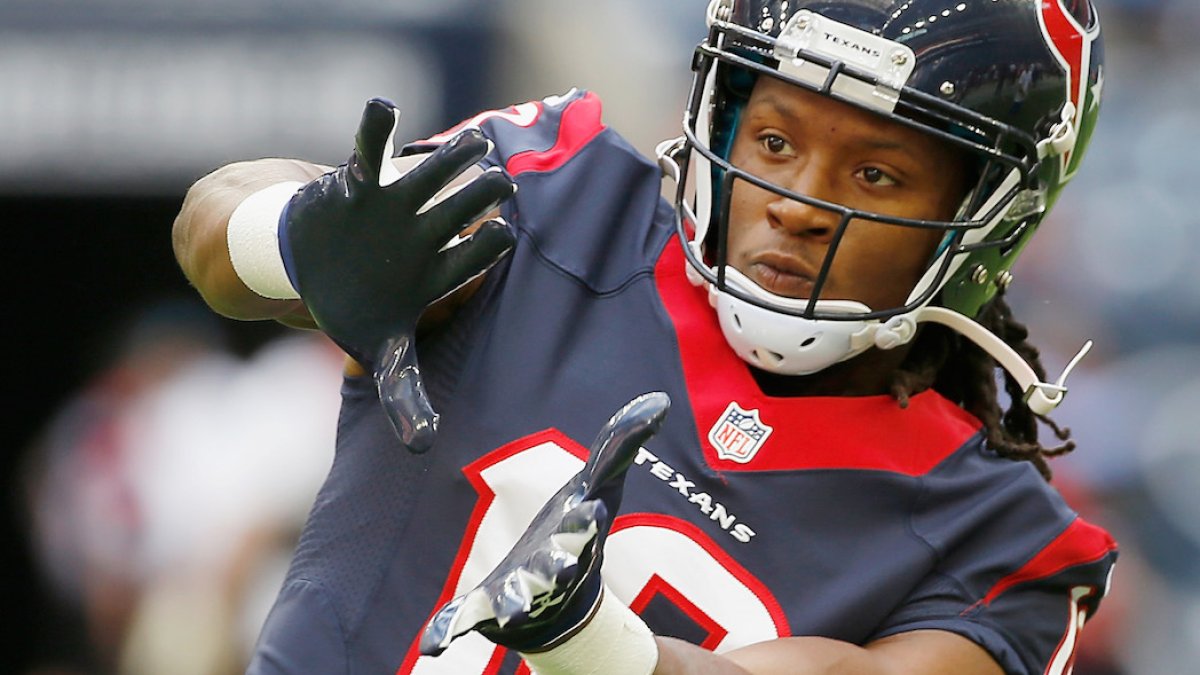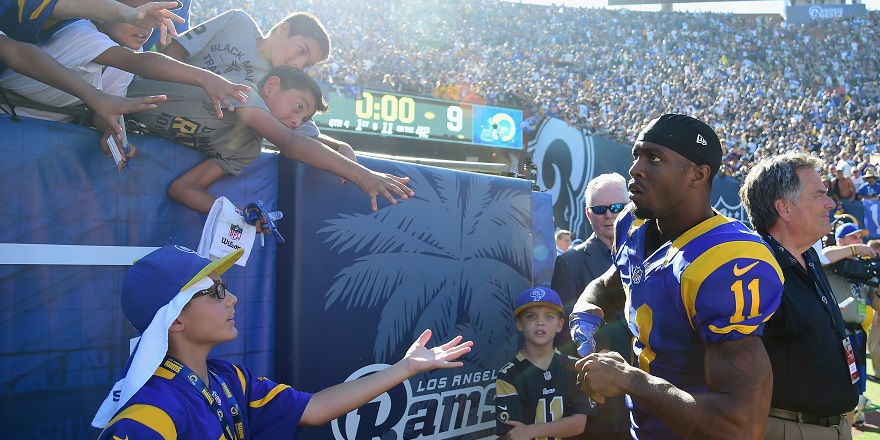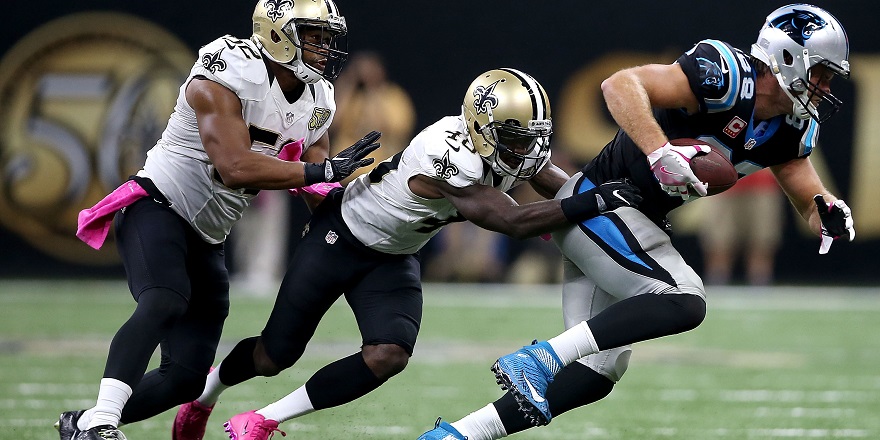(“Today's Crazy Fantasy Stat” is an occasional offseason offering from PFF that highlights something that catches our eye and aids in our preparation for the 2017 fantasy season.)
The last time in this space, I talked about players who scored touchdowns at an unsustainable pace, looking for guys likely to fall off in 2017. Today, it’s similar — players who were surprisingly unproductive in 2016, trying to identify those who might improve.
On the whole, you can expect light touchdown scorers to improve. From 2006 to 2015, 61 players had 100-plus targets with under a 3 percent touchdown rate. On the whole, those 61 had 170 touchdowns on 7,550 targets (2.25 percent). The year after, losing five guys to not playing, the same group had 275 touchdowns on 5,605 targets (4.91 percent), a little more than double the rate.
This isn’t as easy a task, for a variety of reasons. For one, when you’re looking at the top end of touchdown production, you can rest assured that no pass-catchers are that good — there are superstars, but there aren’t touchdown-on-20-percent-of-targets superstars, and until someone disproves that consistently, it’s a truism you can bank on. But while there aren’t guys who are that good, there are, clearly, guys who are that bad. A wide receiver who catches two touchdowns on 120 targets might have gotten unlucky, or he might just be barely good enough to hold an NFL job.
(Subscribe to all our fantasy content, or get everything PFF offers with an All-Access subscription.)
For another reason, some receiver types just aren’t made for touchdowns. Slot types, like Jarvis Landry or Stefon Diggs, can reach pay-dirt, but given their target type, low touchdown productivity is to be expected. For example, Wes Welker scored three touchdowns on 137 targets in 2008 (2.19 percent), then followed it up with four on 152 (2.63 percent) in 2009. Landry was at 2.58 percent in 2015, 3.28 in 2016.
And for a third reason, just like a wide receiver can be that bad, so can his quarterback. In his last three years in Houston, Andre Johnson scored on 2.44 percent of his targets, never topping 2.84 percent in a single season. Was that a product of his own aging? Or an amalgam of bad Texans quarterbacks? Does the fact that he jumped back up to 5.26 percent in Indianapolis signify a better Johnson, a better quarterback or improved luck?
So no, looking for guys with low touchdown rates isn’t as easy as the opposite. That said, in 2016 there were 11 players with 100-plus targets and a touchdown rate of under 3 percent. Let’s look at them, in groups:
Short-target guys
Tavon Austin, Los Angeles Rams
Stefon Diggs, Minnesota Vikings
Jordan Matthews, Philadelphia Eagles
Jeremy Kerley, San Francisco 49ers
Julian Edelman, New England Patriots
As highlighted earlier, the guys who do their work in the slot and/or catch short passes just don’t have as much opportunity to score as their peers, so their touchdown rates are often naturally depressed. Austin (2.97 percent), Kerley (2.78), Diggs (2.75) Matthews (2.75) and Edelman (2.05 percent) all struggled to score in 2016, and while their rates should improve, don’t expect them to skyrocket by any means.
Tight ends
Greg Olsen, Carolina Panthers
Dennis Pitta, Baltimore Ravens
Pitta (1.72 percent) had the lowest touchdown rate of anybody with 100-plus targets a year ago, in part because of his low average depth of target of 6.5 yards and five drops. He’ll be 32 when next season starts with a history of injury and a quarterback who has expressed a desire to throw it deeper in the future. In other words, Pitta might not be a great candidate to rise.
Olsen, meanwhile, scored at a 2.46-percent rate in 2016, easily a career low — he had hovered between 4.6 and 6 percent the last five years, and hadn’t been below 4.58 since his rookie season. He’s a strong candidate for improved touchdown luck in 2016.
Busts
DeAndre Hopkins, Houston Texans
Brandon Marshall, New York Jets
Hopkins (2.90 percent) and Marshall (2.48) had two of the six worst WR Ratings (passer ratings when targeted) among qualified receivers in 2016, in part because of their own struggles, in part because Brock Osweiler and Ryan Fitzpatrick, respectively, were two of the four worst-graded qualified quarterbacks in the league. Both scored at more than double their rates in 2015, but neither has an obvious improved quarterback situation in 2017, and Marshall is definitely on the wrong side of the aging curve.
The question marks
Marqise Lee, Jacksonville Jaguars
Pierre Garçon, Washington
Garçon (2.73 percent) is a free agent, so his 2017 situation is an unknown. He’s only exceeded a 3.03-percent touchdown rate once in the last four seasons. Garçon was PFF’s eighth-graded receiver in 2016 and topped 1,000 yards for the third time in his career, so he has value, but expecting a big touchdown leap is dicey.
Lee (2.97 percent) played his third season in 2016, but his first as a full and healthy participant. He now has five touchdowns on 190 career targets (2.63 percent), but so much of that comes from his 2016 that it’s hard to indict the entire career. If he fully takes Allen Hurns’ role in the Jacksonville offense, he’s worth watching.
The candidates
Greg Olsen, Carolina Panthers
DeAndre Hopkins, Houston Texans
The short-target guys are pretty predictable, while the question marks are by definition unpredictable. Marshall and Pitta are over the hill. Olsen and Hopkins, though, are the candidates. Olsen showed no real signs of decline in 2016 (he actually put up a career-best grade of 87.5), while Hopkins’ struggles appear to be mostly related to Osweiler, who either has to improve in 2017 or won’t be Hopkins’ quarterback anymore. If you’re looking for guys who should score receiving touchdowns more often in 2017, start with those two.





 © 2025 PFF - all rights reserved.
© 2025 PFF - all rights reserved.